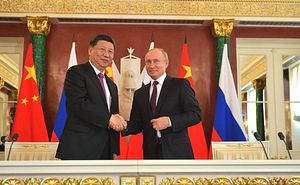While much of the focus in terms of minilateral alignments in the Asian region tends to be on those involving U.S. allies and partners, be it the Quad or U.S.-Japan-ROK trilateral dynamics, there are other arrangements beyond this as well. Of particular note are the arrangements that have been forged by China and Russia over the past few years.
One of these is the China-Russia-Iran relationship. Like many other arrangements, this represents the outgrowth of the combination of existing links between the three countries and recent convergences due to various trends and developments, including growing opposition to the United States that has risen further under President Donald Trump. And it continues to attract headlines about other countries that could join as well, including Pakistan.
Spotlight on the arrangement has been growing in recent weeks with the three countries scheduled to hold their first joint naval drill in the Indian Ocean later this month. Iran’s semi-official Fars news agency reported that the commander of the Iranian Navy, Rear Admiral Hossein Khanzadi, has said that Iran will engage in a trilateral exercise called Marine Security Belt beginning on December 27. Khanzadi revealed that this is part of a broader naval collaboration between Iran and China, which includes also production of destroyers and submarines.
Details have been rather scarce on the engagement. Last week, while speaking to IRNA, Iran’s official news agency, Khanzadi had mentioned that the naval drill will take place in the northern Indian Ocean, although he did not then announce the date. And reports also suggest that both Tehran and Beijing are considering a “long term blueprint of military collaboration.” Confirming Russian participation, Russian Foreign Minister Sergey Lavrov said, “We, the People’s Republic of China, and Iran are preparing naval drills for fighting terrorists and pirates in this part of the Indian Ocean.” Commenting on the trilateral exercise, Lavrov stated on October 2 that the exercise will be undertaken to train their forces in anti-piracy and anti-terrorism efforts.
Irrespective of what is being said and not said publicly, the geopolitical underpinnings of the trilateral group are quite evident: all the three maintain a rather hostile relationship with the United States and have proven increasingly willing to take cooperative actions in the security realm to illustrate their own capabilities. While speaking to the Iranian Mehr News Agency earlier, Rear Admiral Khanzadi had hinted at the fact that a “joint wargame between several countries, whether on land, at sea or in the air, indicates a remarkable expansion of cooperation among them.”
But the strategic significance of this ought to be understood more broadly too. This is a region that has witnessed increasing military activity. The United States conducted a naval operation in Bahrain in November to safeguard shipping in the Persian Gulf waters, which has seen increasing tensions in recent times, and Washington also plans to initiate and lead an International Maritime Security Construct in the Gulf, with the participation of Australia, Bahrain, Saudi Arabia, and the U.K. Other actors are also stepping in, with French Defense Minister Florence Parly saying in November that a European-led maritime surveillance initiative, stationed at the French naval base in Abu Dhabi, UAE, will be engaged in maintaining a watch on the Gulf waters.
The activities of Russia, China, and Iran on their own terms have also attracted interest. Russia has its own initiative, the Collective Security in the Persian Gulf, which is also backed by China. Meanwhile, Iran has plans to pursue a “Hormuz Peace Endeavor” called HOPE, with the Iranian Supreme National Security Council Secretary Ali Shamkhani saying that its own initiative would not include any foreign powers and that it will be a coalition of regional states (while Iran’s naval prowess thus far has been limited to its use of fast boats to harass and chase foreign naval vessels, which has been undertaken by the IRGC and not the actual navy, the Iranian Navy is gaining teeth with acquisition of new drones and other technologies).
Seen from this perspective, China, Iran, and Russia all have an incentive to use the trilateral naval exercise to showcase their growing alignment. From Iran’s perspective, for instance, it has directly said that the trilateral naval exercise is to send a strategic message that the three participating countries have “reached a meaningful strategic point in their relations, with regard to their shared and non-shared interests, and by non-shared I mean the respect we have for one another’s national interests.” China has been more cautious about formal statements, partly because Chinese security analysts say Beijing would not want “to be drawn into Middle East conflicts.”
In the backdrop of these heightened maritime engagements by different coalitions of powers, the China-Iran-Russia trilateral naval exercise will be watched with some concern. As mentioned previously, it is occurring in an area that has seen increased military engagement. Beyond that, for countries like India, there are concerns about additional partners, notably Pakistan, whose potential invitation has been the source of headlines with Rear Admiral Khanzadi mentioning that Islamabad was welcome.
The coming together of China, Iran, and Russia itself is a major strategic development, and the addition of countries like Pakistan into the mix increases the stakes. Irrespective of how things play out, one can expect continued attention to trilateral and quadrilateral configurations such as these that go beyond the ones usually talked about involving U.S. allies and partners.

































